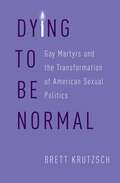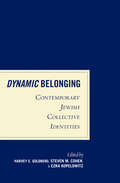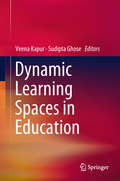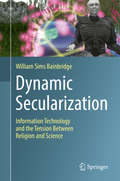- Table View
- List View
Dying Right: The Death with Dignity Movement
by Daniel Hillyard John DombrinkDying Right provides an overview of the Death With Dignity movement, a history of how and why Oregon legalized physician-assisted suicide, and an analysis of the future of physician-assisted suicide. Engaging the question of how to balance a patient's sense about the right way to die, a physician's role as a healer, and the state's interest in preventing killing, Dying Right captures the ethical, legal, moral, and medical complexities involved in this ongoing debate.
Dying to Be Normal: Gay Martyrs and the Transformation of American Sexual Politics
by Brett KrutzschFinalist, Best LGBTQ Nonfiction Book, Lambda Literary Awards 2020 On October 14, 1998, five thousand people gathered on the steps of the U.S. Capitol to mourn the death of Matthew Shepard, a gay college student who had been murdered in Wyoming eight days earlier. Politicians and celebrities addressed the crowd and the televised national audience to share their grief with the country. Never before had a gay citizen's murder elicited such widespread outrage or concern from straight Americans. In Dying to Be Normal, Brett Krutzsch argues that gay activists memorialized people like Shepard as part of a political strategy to present gays as similar to the country's dominant class of white, straight Christians. Through an examination of publicly mourned gay deaths, Krutzsch counters the common perception that LGBT politics and religion have been oppositional and reveals how gay activists used religion to bolster the argument that gays are essentially the same as straights, and therefore deserving of equal rights. Krutzsch's analysis turns to the memorialization of Shepard, Harvey Milk, Tyler Clementi, Brandon Teena, and F. C. Martinez, to campaigns like the It Gets Better Project, and national tragedies like the Pulse nightclub shooting to illustrate how activists used prominent deaths to win acceptance, influence political debates over LGBT rights, and encourage assimilation. Throughout, Krutzsch shows how, in the fight for greater social inclusion, activists relied on Christian values and rhetoric to portray gays as upstanding Americans. As Krutzsch demonstrates, gay activists regularly reinforced a white Protestant vision of acceptable American citizenship that often excluded people of color, gender-variant individuals, non-Christians, and those who did not adhere to Protestant Christianity's sexual standards. The first book to detail how martyrdom has influenced national debates over LGBT rights, Dying to Be Normal establishes how religion has shaped gay assimilation in the United States and the mainstreaming of particular gays as "normal" Americans.
Dying to Be Normal: Gay Martyrs and the Transformation of American Sexual Politics
by Brett KrutzschFinalist, Best LGBTQ Nonfiction Book, Lambda Literary Awards 2020 On October 14, 1998, five thousand people gathered on the steps of the U.S. Capitol to mourn the death of Matthew Shepard, a gay college student who had been murdered in Wyoming eight days earlier. Politicians and celebrities addressed the crowd and the televised national audience to share their grief with the country. Never before had a gay citizen's murder elicited such widespread outrage or concern from straight Americans. In Dying to Be Normal, Brett Krutzsch argues that gay activists memorialized people like Shepard as part of a political strategy to present gays as similar to the country's dominant class of white, straight Christians. Through an examination of publicly mourned gay deaths, Krutzsch counters the common perception that LGBT politics and religion have been oppositional and reveals how gay activists used religion to bolster the argument that gays are essentially the same as straights, and therefore deserving of equal rights. Krutzsch's analysis turns to the memorialization of Shepard, Harvey Milk, Tyler Clementi, Brandon Teena, and F. C. Martinez, to campaigns like the It Gets Better Project, and national tragedies like the Pulse nightclub shooting to illustrate how activists used prominent deaths to win acceptance, influence political debates over LGBT rights, and encourage assimilation. Throughout, Krutzsch shows how, in the fight for greater social inclusion, activists relied on Christian values and rhetoric to portray gays as upstanding Americans. As Krutzsch demonstrates, gay activists regularly reinforced a white Protestant vision of acceptable American citizenship that often excluded people of color, gender-variant individuals, non-Christians, and those who did not adhere to Protestant Christianity's sexual standards. The first book to detail how martyrdom has influenced national debates over LGBT rights, Dying to Be Normal establishes how religion has shaped gay assimilation in the United States and the mainstreaming of particular gays as "normal" Americans.
Dynamic Asia: Business, Trade and Economic Development in Pacific Asia (Routledge Revivals)
by Ian G. Cook Marcus A. Doel Rex Y. F. Li Yongjiang WangPublished in 1998, this book examines the challenges and opportunities for international business and trade in the Asia-Pacific region, highlighting the dynamic and complexities of the region.
Dynamic Asia: Business, Trade and Economic Development in Pacific Asia (Routledge Revivals)
by Ian G. Cook, Marcus A. Doel, Rex Y.F. Li and Yongjiang WangPublished in 1998, this book examines the challenges and opportunities for international business and trade in the Asia-Pacific region, highlighting the dynamic and complexities of the region.
Dynamic Belonging: Contemporary Jewish Collective Identities
by Harvey E. Steven M. Cohen Ezra KopelowitzWorld Jewry today is concentrated in the US and Israel, and while distinctive Judaic approaches and practices have evolved in each society, parallels also exist. This volume offers studies of substantive and creative aspects of Jewish belonging. While research in Israel on Judaism has stressed orthodox or “extreme” versions of religiosity, linked to institutional life and politics, moderate and less systematized expressions of Jewish belonging are overlooked. This volume explores the fluid and dynamic nature of identity building among Jews and the many issues that cut across different Jewish groupings. An important contribution to scholarship on contemporary Jewry, it reveals the often unrecognized dynamism in new forms of Jewish identification and affiliation in Israel and in the Diaspora.
Dynamic Capabilities: How Organisational Structures Affect Knowledge Processes
by Philip Cordes-BerszinnThe concept of dynamic capabilities, especially in terms of organizational knowledge processes, has become the predominant paradigm for the explanation of competitive advantages. However, major unsolved - or at least insufficiently solved - problems are first their measurement and second their management by concrete managerial options, such as design options of organizational structures. Dynamic Capabilities provides an integrated descriptive model of both dynamic capabilities and organizational structures that allows characterizing, classifying and a comparison. It develops a logic system of a multitude of combinatorial possibilities between their variables, and it develops a complex and integrated system of associated empirically based and qualitatively deduced hypotheses. Therewith, it serves as a terminological and analytical foundation for the identification of knowledge-based dynamic capabilities in organizations and for a targeted design of organizational structures that enable and foster dynamic capability processes such as knowledge transfer and knowledge absorption.
Dynamic Data Driven Applications Systems: Third International Conference, DDDAS 2020, Boston, MA, USA, October 2-4, 2020, Proceedings (Lecture Notes in Computer Science #12312)
by Sai Ravela Erik Blasch Alex Aved Frederica DaremaThis book constitutes the refereed proceedings of the Third International Conference on Dynamic Data Driven Application Systems, DDDAS 2020, held in Boston, MA, USA, in October 2020. The 21 full papers and 14 short papers presented in this volume were carefully reviewed and selected from 40 submissions. They cover topics such as: digital twins; environment cognizant adaptive-planning systems; energy systems; materials systems; physics-based systems analysis; imaging methods and systems; and learning systems.
Dynamic Demographic Analysis (The Springer Series on Demographic Methods and Population Analysis #39)
by Robert SchoenThis volume presents state of the art analyses from scholars dealing with a range of demographic topics of current concern, including longevity, mortality and morbidity, migration, and how population composition impacts intergenerational transfer schemes. New approaches are applied to such issues as measuring changes in cohort survivorship in low mortality populations, patterns of mortality improvement at older ages, and the consequences of heterogeneity in the susceptibility to death. Studies examine models of the current status of the HIV/AIDS epidemic, advance present methods for estimating population change in small areas, and strive to disentangle age, period, and cohort effects. In sum, the book addresses key contemporary issues in measuring and modeling dynamic populations, and advances the frontier of dynamic demography.
Dynamic Interpretation of Early Cities in Ancient China
by Hong XuThis book offers an archaeological study on China’s ancient capitals. Using abundant illustrations of ancient capital sites, it verifies the archaeological discoveries with documentary records. The author introduces the dynamical interpretation of each ancient capital to the interpretation of the entire development history of China's ancient capitals. The book points out that for most of the almost 2000 years from the earliest Erlitou (二里头)to the Ye city (邺城), there was an era where ancient capitals didn’t have outer enclosures due to factors such as the strong national power, the military and diplomatic advantage, the complexity of the residents, and the natural conditions. Thus an era of “the huge ancient capitals without guards” lasting for over 1000 years formed. The concept that “China’s ancient capitals don’t have outer enclosures” presented in the book questions the traditional view that “every settlement has walled enclosures”. Combining science with theory, it offers researchers of history a clear understanding of the development process of China’s ancient capitals.
Dynamic Learning Spaces in Education
by Veena Kapur Sudipta GhoseThis volume discusses the need for a major paradigm shift in educational practice in the current digital and globalized world. It establishes a bridge between theory and praxis and revisits the objectives of learning and its modalities within the context of a rapidly evolving global world order. This volume includes perspectives from different countries on creating a dynamic and adaptive education system that encourages creativity, leadership, flexibility, and working in virtual as well as inclusive environments. The four sections include chapters that discuss creating meaningful learning environments, preparing teachers for new age classrooms, the digital learning space, fostering change in classrooms, and importantly also includes cases and experiments from schools. The authors are teacher educators, teachers and researchers, and each chapter, while being deeply rooted in theory, is juxtaposed with informed practice, making the suggestions easy to implement in different settings. This is an important resource for researchers and practitioners associated with education systems in creating engaging, meaningful and future-ready education practices.
Dynamic Population Models (The Springer Series on Demographic Methods and Population Analysis #17)
by Robert SchoenDynamic Population Models is the first book to comprehensively discuss and synthesize the emerging field of dynamic modeling. Incorporating the latest research, it includes thorough discussions of population growth and momentum under gradual fertility declines, the impact of changes in the timing of events on fertility measures, and the complex relationship between period and cohort measures. The book is designed to be accessible to those with only a minimal knowledge of calculus.
Dynamic Process Methodology in the Social and Developmental Sciences
by Maria C.D.P. Lyra Nandita Chaudhary Jaan Valsiner Peter C. M. MolenaarAll psychological processes—like biological and social ones—are dynamic. Phenomena of nature, society, and the human psyche are context bound, constantly changing, and variable. This feature of reality is often not recognized in the social sciences where we operate with averaged data and with homogeneous stereotypes, and consider our consistency to be the cornerstone of rational being. Yet we are all inconsistent in our actions within a day, or from, one day to the next, and much of such inconsistency is of positive value for our survival and development. Our inconsistent behaviors and thoughts may appear chaotic, yet there is generality within this highly variable dynamic. The task of scientific methodologies—qualitative and quantitative—is to find out what that generality is. It is the aim of this handbook to bring into one framework various directions of construction of methodology of the dynamic processes that exist in the social sciences at the beginning of the 21st century. This handbook is set up to bring together pertinent methodological scholarship from all over the world, and equally from the quantitative and qualitative orientations to methodology. In addition to consolidating the pertinent knowledge base for the purposes of its further growth, this book serves the major educational role of bringing practitioners—students, researchers, and professionals interested in applications—the state of the art know-how about how to think about extracting evidence from single cases, and about the formal mathematical-statistical tools to use for these purposes.
Dynamic Secularization: Information Technology and the Tension Between Religion and Science
by William Sims BainbridgeThis book discusses secularization, arguing that it may be more complex and significant than is generally recognized. Using a number of online exploration methods, the author provides insights into how religion may be changing, and how information technology might be energized in this process.Working from the premise that the relationship between science and religion is complex, the author demonstrates that while science has contradicted some specific religious beliefs, science itself may have been facilitated by beliefs formed many centuries ago. Science assists engineers in the development of powerful new technologies, and asserts that the universe is based on a set of fundamental principles that can be understood by humans through the assistance of mathematics. The challenging ideas discussed will benefit readers through sharing a variety of Internet-based research methods and cultural discoveries. The book provides a balance between quantitative methods, illustrated by 24 tables of statistics, and qualitative methods, illustrated by 30 screenshots of computer-generated virtual worlds. Analysis interweaves with description, creating a sense of involvement in the experience of exploring online realities at the same time as radical insights are shared.
Dynamic Strategy-Making: A Real-Time Approach for the 21st Century Leader
by Larry E. Greiner Thomas G. CummingsPraise for Dynamic Strategy-Making "An astonishingly timely, hopeful, and important book that recasts and freshly imagines strategy-making and integrates theory with practice in the field of strategic management. A must-read for all those who want to learn more about the future of strategy practice and become more skillful at it." —WARREN BENNIS, Distinguished Professor of Business, University of Southern California; and coauthor, Transparency "This is one of the most valuable resources ever created for strategists and leaders in organizations. It uniquely combines concepts of leadership and organization with strategy content and implementation in a pragmatic and integrated approach that makes tremendous sense for our times. With concrete cases, it provides a clear road map for those who want and need to do a better job of formulating and implementing strategy." —DAVID A. NADLER, vice chairman, Marsh & McLennan Companies; senior partner, Oliver Wyman-Delta Organization and Leadership; and author, Building Better Boards and Competing By Design "The authors correctly focus on the new dynamic of 24/7 competition and change and the need for organizations to be fast, fluid, and flexible. It is a must-read for managers of tomorrow and offers a number of practical insights and lessons on how to proceed with strategy execution that can be readily adopted in any organization. It is a call to action that few can afford to ignore." —MANJIT SINGH, chairman, Sony Entertainment Television, India; and former CEO, Compete Inc., High Circle, Future Step, and Korn/Ferry International
Dynamic Strategy-Making: A Real-Time Approach for the 21st Century Leader
by Larry E. Greiner Thomas G. CummingsPraise for Dynamic Strategy-Making "An astonishingly timely, hopeful, and important book that recasts and freshly imagines strategy-making and integrates theory with practice in the field of strategic management. A must-read for all those who want to learn more about the future of strategy practice and become more skillful at it." —WARREN BENNIS, Distinguished Professor of Business, University of Southern California; and coauthor, Transparency "This is one of the most valuable resources ever created for strategists and leaders in organizations. It uniquely combines concepts of leadership and organization with strategy content and implementation in a pragmatic and integrated approach that makes tremendous sense for our times. With concrete cases, it provides a clear road map for those who want and need to do a better job of formulating and implementing strategy." —DAVID A. NADLER, vice chairman, Marsh & McLennan Companies; senior partner, Oliver Wyman-Delta Organization and Leadership; and author, Building Better Boards and Competing By Design "The authors correctly focus on the new dynamic of 24/7 competition and change and the need for organizations to be fast, fluid, and flexible. It is a must-read for managers of tomorrow and offers a number of practical insights and lessons on how to proceed with strategy execution that can be readily adopted in any organization. It is a call to action that few can afford to ignore." —MANJIT SINGH, chairman, Sony Entertainment Television, India; and former CEO, Compete Inc., High Circle, Future Step, and Korn/Ferry International
Dynamic Systems for Everyone: Understanding How Our World Works
by Asish GhoshThis book is a study of the interactions between different types of systems, their environment, and their subsystems. The author explains how basic systems principles are applied in engineered (mechanical, electromechanical, etc.) systems and then guides the reader to understand how the same principles can be applied to social, political, economic systems, as well as in everyday life. Readers from a variety of disciplines will benefit from the understanding of system behaviors and will be able to apply those principles in various contexts. The book includes many examples covering various types of systems. The treatment of the subject is non-mathematical, and the book considers some of the latest concepts in the systems discipline, such as agent-based systems, optimization, and discrete events and procedures.
Dynamic Systems for Everyone: Understanding How Our World Works
by Asish GhoshSystems are everywhere and we are surrounded by them. We are a complex amalgam of systems that enable us to interact with an endless array of external systems in our daily lives. They are electrical, mechanical, social, biological, and many other types that control our environment and our well-being. By appreciating how these systems function, will broaden our understanding of how our world works. Readers from a variety of disciplines will benefit from the knowledge of system behavior they will gain from this book and will be able to apply those principles in various contexts. The treatment of the subject is non-mathematical, and the book considers some of the latest concepts in the systems discipline, such as agent based systems, optimization, and discrete events and procedures. The diverse range of examples provided in this book, will allow readers to:Apply system knowledge at work and in daily life without deep mathematical knowledge;Build models and simulate system behaviors on a personal computer; Optimize systems in many different ways;Reduce or eliminate unintended consequences;Develop a holistic world view .This book will enable readers to not only better interact with the systems in their professional and daily lives, but also allow them to develop and evaluate them for their effectiveness in achieving their designed purpose.Comments from Reviewers: “This is a marvelously well written introduction to Systems Thinking and System Dynamics - I like it because it introduces Systems Thinking with meaningful examples, which everyone should be able to readily connect” - Gene Bellinger, Organizational theorist, systems thinker, and consultant, Director Systems Thinking World “Excellent book ...very well written. Mr. Ghosh's world view of system thinking is truly unique” - Peter A. Rizzi, Professor Emeritus, University of Massachusetts Dartmouth “A thorough reading of the book provides an interesting way to view many problems in our society” –Bradford T. Stokes, Poppleton Chair and Professor Emeritus, The Ohio State University College of Medicine “This is a very good and very readable book that is a must read for any person involved in systems theory in any way - which may actually include just about everyone” - Peter G. Martin, Vice President Business Value Consulting, Schneider Electric
A Dynamic Systems Theory Perspective on L2 Writing Development (China Perspectives)
by Shaopeng LiFrom the perspective of empirical complex dynamic systems, this book investigates the complex and nonlinear process of L2 writing centering on three linguistic aspects of L2 writing development: vocabulary, syntax, and discourse.Combining dynamic systems theory, variation analysis, as well as data and cases studies from Chinese EFL learners’ writing, the book critically engages with the heated discussion on dynamic patterns of L2 writing development that focus heavily on the linguistic dimensions of complexity, accuracy, and fluency. The author expands the scope of the research by integrating both linguistic and functional dimensions of L2 output and examines the interaction and co-development of these dimensions. This framework helps delineate a full picture of individual learners’ L2 writing dynamic patterns across all components of their communicative repertoire. The research findings suggest the developmental path of writing system for each EFL learner may differ, which is influenced by their different learning characteristics and learning environments in China.The title will appeal to scholars interested in applied linguistics and second language acquisition. Suggestions on pedagogy and language learning advanced in the book will also make it a useful read for L2 language learner and TESOL and TEFL teachers.
A Dynamic Systems Theory Perspective on L2 Writing Development (China Perspectives)
by Shaopeng LiFrom the perspective of empirical complex dynamic systems, this book investigates the complex and nonlinear process of L2 writing centering on three linguistic aspects of L2 writing development: vocabulary, syntax, and discourse.Combining dynamic systems theory, variation analysis, as well as data and cases studies from Chinese EFL learners’ writing, the book critically engages with the heated discussion on dynamic patterns of L2 writing development that focus heavily on the linguistic dimensions of complexity, accuracy, and fluency. The author expands the scope of the research by integrating both linguistic and functional dimensions of L2 output and examines the interaction and co-development of these dimensions. This framework helps delineate a full picture of individual learners’ L2 writing dynamic patterns across all components of their communicative repertoire. The research findings suggest the developmental path of writing system for each EFL learner may differ, which is influenced by their different learning characteristics and learning environments in China.The title will appeal to scholars interested in applied linguistics and second language acquisition. Suggestions on pedagogy and language learning advanced in the book will also make it a useful read for L2 language learner and TESOL and TEFL teachers.
The Dynamics and Complexities of Interracial Gay Families in South Africa: Gay Relationships In South Africa (Springerbriefs In Sociology)
by Oluwafemi AdeagboThis book provides an in-depth account of a qualitative study on the familial arrangements and domestic settings shaping interracial gay partnerships in the South African context, and it offers both empirical and theoretical insights on the topic. While heterosexual intimate relationships, particularly mixed-race couples, have attracted societal and scholarly attention in South Africa due to the country’s past history of racial segregation, it is, however, striking how little emphasis is placed on understanding same-sex unions in a transforming South Africa. This book is timely and important because it explores the vignettes, complexities and dynamics of interracial gay intimate relationships, an area that hardly gets the scholarly attention it deserves. The book addresses the intersectionality, and the question of how sexuality, gender, racial identity and personal resources influence the relationship as well as the way resilience strategies are drawn upon to sustain the partnership.
The Dynamics and Evolution of Social Systems: New Foundations of a Mathematical Sociology (Theory and Decision Library A: #29)
by Jürgen KlüverWhen I started with this book several years ago I originally intended to write an introduction to mathematical systems theory for social scientists. Yet the more I thought about systems theory on the one side and theoretical sociology on the other the more I became convinced that the classical mathematical tools are not very well suited for the problems of sociology. Then I became acquainted with the researches on complex systems by the Santa Fe Institute and in particular with cellular automata, Boolean networks and genetic algorithms. These mathematically very simple but extremely efficient tools are, in my opinion, very well appropriate for modeling social dynamics. Therefore I tried to reformulate several classical problems of theoretical sociology in terms of these formal systems and outline new possibilities for a mathematical sociology which is able to join immediately on the great traditions of theoretical sociology. The result is this book; whether I succeeded with it is of course up to the readers. As the readers will perceive, the book could not have been written by me alone but only by the joint labors of the computer group at the Interdisciplinary Center of Research in Higher Education at the University of Essen. The members of the group, Christina Stoica, Jom Schmidt and Ralph Kier, are named in several subchapters as co-authors. Yet even more important than their contributions to this book were the permanent discussions with them and their patience with my new and very speculative ideas. Many thanks.
The Dynamics and Social Outcomes of Education Systems (Education, Economy and Society)
by Jan Germen Janmaat, Marie Duru-Bellat, Andy Green and Philippe M�hautSome scholars argue that education systems across the western world are becoming increasingly similar due to the influence of transnational discourses and organizations. Others believe that education is the panacea for all problems of social cohesion. After all, aren't the well-educated usually more tolerant, civically engaged and trusting than the poorly educated? This book critically examines both claims. It finds that western countries still differ markedly on key aspects of their education systems and that these differences reflect distinct political traditions and different responses to a set of competing normative and political principles. The findings further suggest that raising the average education level is unlikely to be an effective strategy for promoting social cohesion. Instead, more promising are policies targeting the opposite ends of the lifelong learning continuum: universalizing pre-school education and care and promoting adult education with a pronounced second chance character.
The Dynamics of Advertising
by Jackie Botterill Iain MacRury Barry RichardsThe authors suggest that advertisments, while important in our daily emotional self-management, are far more closely linked to the pragmatics of everyday life than their symbolic richness might suggest. Recent trends in advertisment content point to an important shift in our relationship to goods that reflects an increasing preoccupation with risk management.
The Dynamics of Advertising
by Jackie Botterill Iain MacRury Barry RichardsThe authors suggest that advertisments, while important in our daily emotional self-management, are far more closely linked to the pragmatics of everyday life than their symbolic richness might suggest. Recent trends in advertisment content point to an important shift in our relationship to goods that reflects an increasing preoccupation with risk management.



















